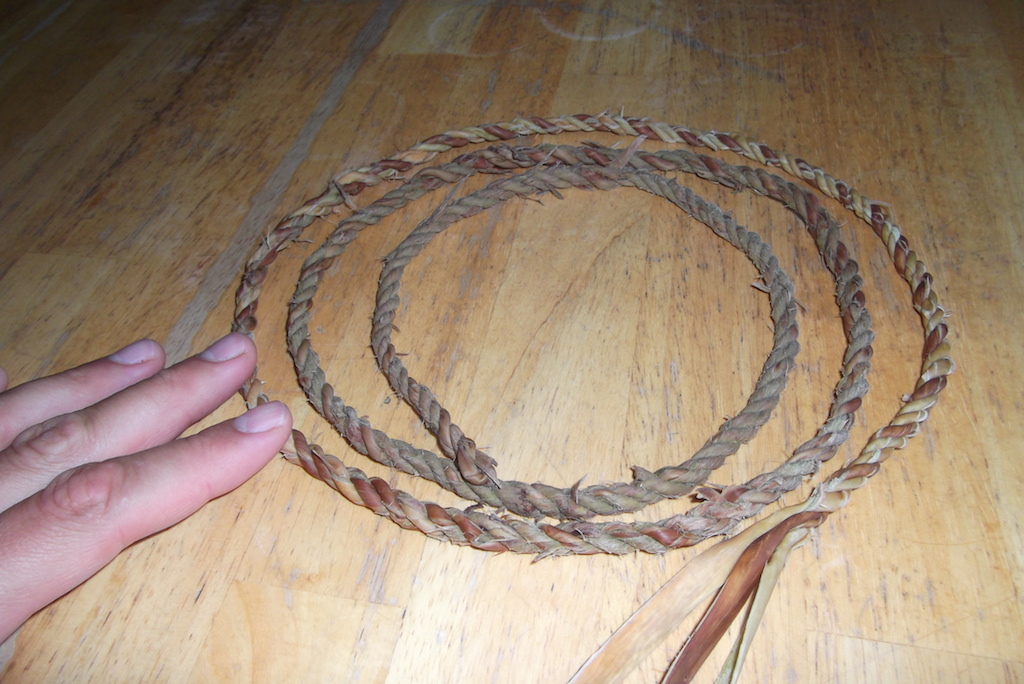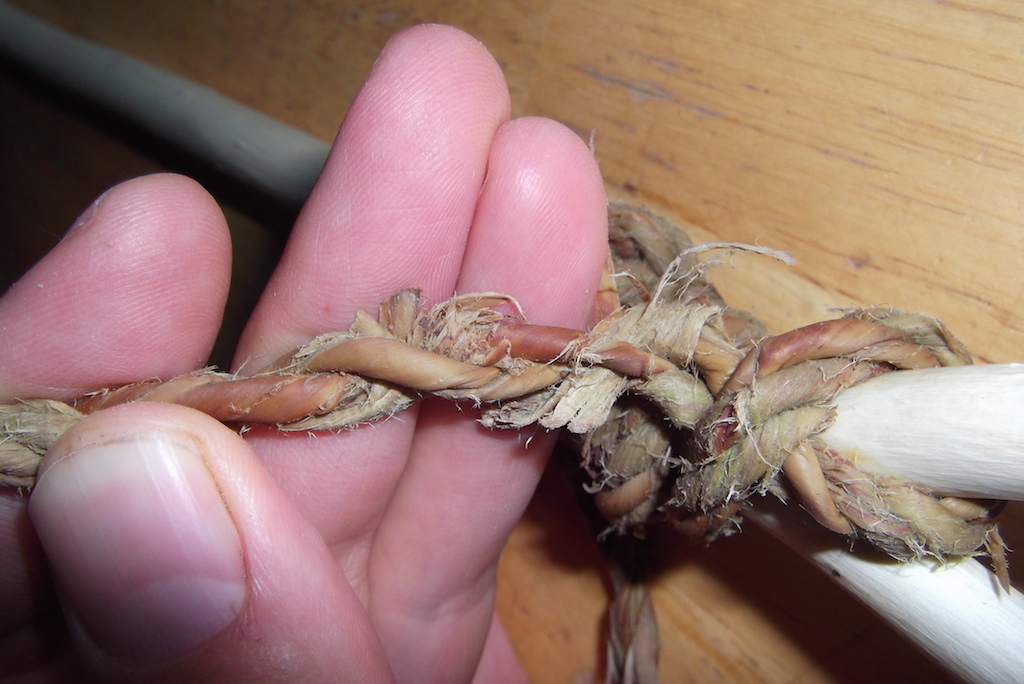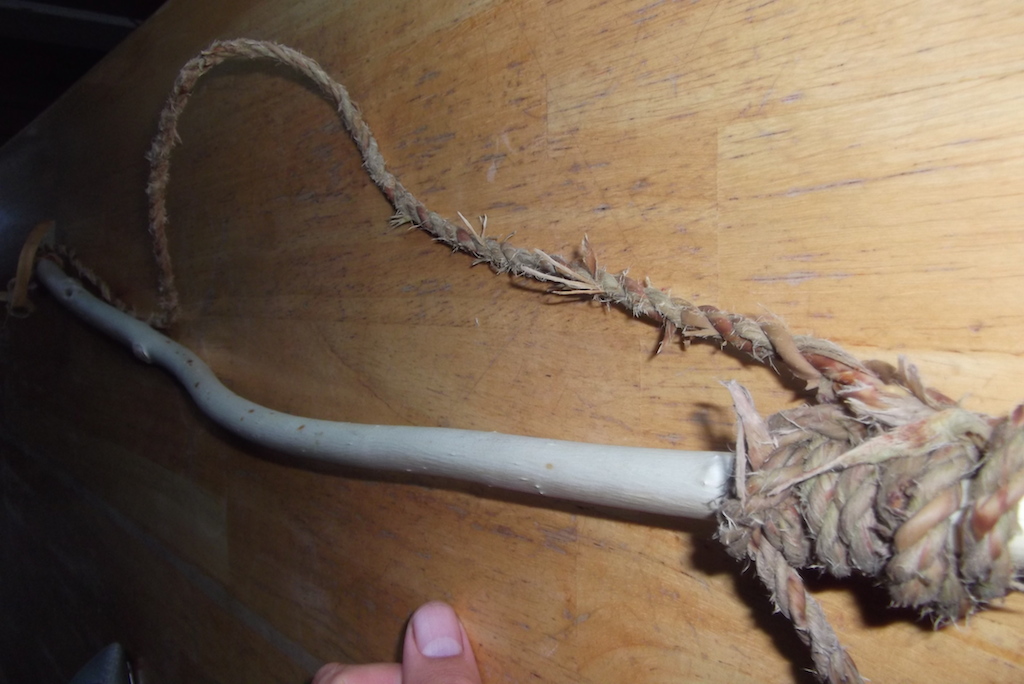Acorns
Marcel's blog
Willow Bow Drill Cordage
I had partial success with making a willow bark bow string for a bow drill.
At 4EEE’s family wilderness experience last week, I made a bow drill kit. The spindle and fireboard are made from cottonwood, and the bow string was parachute cord. After starting a couple fires with it, I was looking for ways to experiment. The parachute cord bow string seemed incongruous with the other natural, hand-made parts, so I set out to replace it.
I harvested some fresh willow and prepared some 3/8" strips of inner bark. I twisted it into three-strand cordage which turned out to be about 1/4" in diameter.

While trying to start a coal, one strand broke. It broke right at a small knot hole in the bark that didn’t roll quite as uniformly. I think that started a tear in that strand. (I’ll discuss this more below under “Processing”).
I was able to mend that by twisting the broken strand back into the other two to keep it from unraveling and repositioning the break closer to the end of the bow.

With that mended, I was able to start a coal! But it surely put a lot of wear on the bow string.

I’m not quite sure what to try next. I might try letting the cordage dry more to see how brittle it gets, or I might first try to splice in another strand around the breakage.
Thanks to the 4EEE team for pointing me in the right direction, especially Matthew, John, and Rick.
Materials
I chose willow bark for the bow string because it was abundant in the area, and I had just learned how to process it for cordage. However, I also got some cautions that it might not be up to the task. Dogbane might be a more durable choice.
On the first branch that I selected, the bark didn’t peel cleanly. I had better results with another plant that was growing closer to water.
The opportunity to harvest wild materials is special and unusual for me. Usually I’m in a state or county park that doesn’t permit it, even if it’s done in a way that supports the health of the land, such as coppicing, strategic thinning, or removing excessive deadwood.
Freshness
I had more difficulty peeling the third branch than the second, even though they were from the same willow plant. I’m not sure whether this is natural variation; I suspect that it’s because the second branch sat in my roof rack for the day’s journey home before I peeled it. The bark was just more stuck to the branch. The first branch, which I abandoned as unpeelable, was similar to this third one.
Soaking the branch in my bathtub for a few hours helped rehydrate the branch. I wonder if soaking the first one would have made it usable.
Processing
As mentioned above, the tear in one of the strands happened at a little knot hole where I wasn’t able to scrape all of the outer bark from the inner bark. The little bit of brittle outer bark that remained probably contributed to the tear by preventing the fibers from twisting supplely to bear the tension evenly. I had seen several of these as I was twisting the strands. I wasn’t sure about the trade-off between leaving small imperfections such as this one versus cutting them out and splicing together more shorter strips of bark. Next time I’d err more on the side of shorter strands.
Also, when cutting strips of bark for each strand of cordage, I didn’t account for the varying thickness of the bark. The bark at the base of the branch was thicker, so I would have gotten more evenly sized strands if I narrowed the strips toward the base.
I got a variety of instructions for how to separate the inner bark. Some favored peeling the bark from the branch before removing the outer bark, whereas some favored the other way around, removing the outer bark while still on the branch. I found that, given the trouble I had peeling the bark from the branch, stripping it after peeling made the peeling easier. Similarly, some favored slicing the outer bark off of the inner bark with the sharp edge of a knife whereas some favored scraping the outer bark off with the back of the knife. For me, it was easier for me to scrape with the back of a knife than to slice. I draped the bark over a cobble stone; the convex surface allowed me to focus the pressure where the outer bark was most stubborn.
Knots
The cordage was stiff, so I was worried about how much strain knots would put on it. I tried to avoid sharp folds of the bow string over itself when tying it to the bow. A knot like the timber hitch requires this type of narrow fold.
I used variations of a clove hitch on both ends instead of using a timer hitch on one end. This seemed to be effective as neither knot was the site of excessive wear, though I don’t really know whether the timber hitch would have been a problem.
Tension Adjustment
The rope stretched a lot as I used it the first time. Even though I got a nice tight wrap around the spindle to start, it started to slip after a few dozen strokes of the bow.
At first, I stopped to tighten the string, thinking it was just some initial stretching. But it kept happening, so I tried adjusting tension “on the fly” as Matthew taught me. This allowed me to eventually get a coal and flame.
The stretch of the cordage might have been exacerbated by using it while still damp. I wasn’t sure whether to let it dry. I chose to try it wet because I worried it might become brittle when dry.